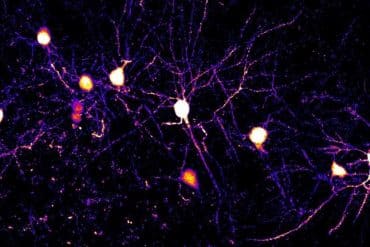Summary: Lactation triggers significant metabolic changes in mothers, driven by shifting hormone levels and brain activity. Researchers have now uncovered how increased prolactin and reduced estrogen suppress specific neurons in the hypothalamus to boost appetite and conserve fat, meeting the energy demands of nursing.
Removing estrogen receptor α (ERα) neurons in this brain region mimicked lactation, while reactivating them reversed these effects. This mechanism not only explains maternal metabolic shifts but may also hold clues for conditions like obesity, menopause, and hyperprolactinemia.
Key Facts:
- Brain-Hormone Link: Estrogen receptor α neurons in the hypothalamus regulate prolactin and energy balance during lactation.
- Metabolic Switch: Decreased ERα activity leads to increased appetite and reduced fat-burning to sustain milk production.
- Clinical Potential: Findings could inform treatments for obesity, menopause, and high prolactin disorders.
Source: Baylor College of Medicine
Nursing poses major metabolic demands on mothers, to which they respond by eating more and saving energy to sustain milk production. There are significant hormonal changes during lactation, but how they lead to metabolic adaptations in nursing mothers remained unclear.
In this study, which appeared in Nature Metabolism, leading researchers at Baylor College of Medicine and Pennington Biomedical Research Center uncovered a mechanism that connects prolactin, estrogen, the brain and metabolic adaptations during lactation.

“We worked with animal models to investigate how hormones and the brain work together to adapt to the metabolic demands nursing mothers face to sustain milk production,” said co-corresponding author Dr. Chunmei Wang, assistant professor of pediatrics at the USDA/ARS Children’s Nutrition Research Center at Baylor.
“Normally, estrogen helps control appetite and increases the body’s ability to burn fat, while prolactin does the opposite.
“During lactation, estrogen levels drop, and prolactin levels rise, leading to increased hunger and reduced fat-burning to compensate for extra energy demands posed by milk production and consumption,” said co-corresponding author Dr. Yanlin He, associate professor at Pennington Biomedical Research Center.
“We found that brain cells called estrogen receptor α (ERα) neurons in a small area of the hypothalamus are significantly less active during lactation,” said co-first author Dr. Meng Yu, postdoctoral associate in the Wang lab.
“We showed that when ERα is deleted from these neurons, prolactin levels rise, and the animals increase their appetite and save energy by burning less fat. It was striking to see that just eliminating ERα in this tiny brain region was able to sustain such major metabolic consequences.”
“When ERα neurons were removed in non-lactating female mice, the animals showed high prolactin levels and lactation-like changes – eating more and burning less fat. Reactivating these neurons in lactating mice reduced these effects, showing their role in controlling metabolism,” He said.
“I am excited that we have discovered a novel mechanism for prolactin regulation,” Wang said. “We knew that prolactin is produced by pituitary cells, and estrogen can act on these cells to increase prolactin levels.
“Here we found a novel role of estrogen in regulating prolactin levels – it activates ERα neurons in the hypothalamus, which in turn inhibits prolactin levels during lactation. These findings have potential clinical applications.”
“The study sheds light on how the brain integrates hormonal signals to regulate energy balance, which could have broader implications for understanding hyperprolactinemia – high levels of prolactin in the blood – obesity, menopause and other conditions where prolactin or estrogen levels shift.
“This work opens exciting avenues for future research on neuroendocrine control of metabolism,” He said.
Other contributors to this work include co-first authors Bing Feng and Jonathan C. Bean, as well as Qianru Zhao, Yongjie Yang, Hailan Liu, Yongxiang Li, Benjamin P. Eappen, Hesong Liu, Longlong Tu, Kristine M. McDermott, Mengjie Wang, Xi Chen, Na Yin, Darah Ave Threat, Nathan Xu, Junying Han, Peiyu Gao, Yi Zhu, Darryl L. Hadsell, Yang He and Pingwen Xu. The authors are affiliated with one of the following institutions: Baylor College of Medicine, Pennington Biomedical Research Center or the University of Illinois at Chicago.
Funding: This work was supported by grants from the National Institutes of Health (R01DK129548, R56DK133776, R00DK107008, P30 DK020595, R01DK123098, R01 DK136627, K01DK119471), USDA/CRIS (3092-51000-062-04(B)S, a TCH-2023 Pediatric Pilot award, a fellowship award 3092-51000-056, American Heart Association awards (20POST35120600 and 20POST000204188) and a DOD Innovative Grant (W81XWH-20-1-0075).
About this neuroscience research news
Author: Taylor Barnes
Source: Baylor College of Medicine
Contact: Taylor Barnes – Baylor College of Medicine
Image: The image is credited to Neuroscience News
Original Research: Closed access.
“Falling hypothalamic estrogenic signal sustains lactational hyperprolactinemia and metabolic adaptations” by Chunmei Wang et al. Nature Metabolism
Abstract
Falling hypothalamic estrogenic signal sustains lactational hyperprolactinemia and metabolic adaptations
17β-oestradiol (E2) inhibits overeating and promotes brown adipose tissue (BAT) thermogenesis, whereas prolactin (PRL) does the opposite.
During lactation, the simultaneous decline in E2 and surge in PRL contribute to maternal metabolic adaptations, including hyperphagia and suppressed BAT thermogenesis. However, the underlying neuroendocrine mechanisms remain unclear.
Here, we find that oestrogen receptor alpha (ERα)-expressing neurons in the medial basal hypothalamus (MBH), specifically the arcuate nucleus of the hypothalamus and the ventrolateral subdivision of the ventromedial hypothalamus (vlVMH), are suppressed during lactation.
Deletion of ERα from MBH neurons in virgin female mice induces metabolic phenotypes characteristic of lactation, including hyperprolactinemia, hyperphagia and suppressed BAT thermogenesis. By contrast, activation of ERαvlVMH neurons in lactating mice attenuates these phenotypes.
Overall, our study reveals an inhibitory effect of E2–ERαvlVMH signalling on PRL production, which is suppressed during lactation to sustain hyperprolactinemia and metabolic adaptations.






